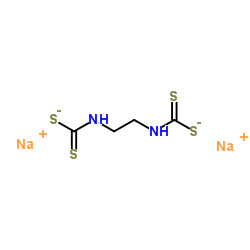Ultrastructural and histological study of degenerative changes in the antennal glands, hepatopancreas, and midgut of grass shrimp exposed to two dithiocarbamate biocides.
D G Doughtie, K R Rao
Index: J. Invertebr. Pathol. 41(3) , 281-300, (1983)
Full Text: HTML
Abstract
The histological and ultrastructural alterations observed in the antennal glands, hepatopancreas, and midgut of grass shrimp exposed to either a 50% potassium dimethyldithiocarbamate biocide (Busan-85; 5–60 ppb) for 14 days, or to a different biocide, composed of 15% sodium dimethyldithiocarbamate and 15% disodium ethylene bisdithiocarbamate (Aquatreat DNM-30), for 3–4 days (60–140 ppb) and 28–35 days (40–120 ppb), were compared and contrasted with the normal morphological features in control shrimp. Only those experimental shrimp that exhibited various degrees of branchial abnormality were examined. Although the alterations in Busan-exposed shrimp were generally more pronounced, the antennal glands of 32 out of 36 experimental shrimp exhibited abnormalities that were manifested primarily as increased secretory activity by the labyrinth cells. In dithiocarbamate-exposed shrimp with “black gills”, the labyrinth epithelium exhibited moderate nuclear hypertrophy, apparent cell sloughing, intense secretory activity, and occasional melanized lesions; alterations in the antennal gland coelomosac included nuclear pyknosis, a general deterioration of podocyte organization, and an unusual increase in hemolymph density adjacent to affected tissues. Although there was an apparent increase in mitotic activity in the hepatopancreatic tubules of shrimp exposed to Aquatreat for 28–35 days, degenerative changes were most frequent and extensive in the hepatopancreas and midgut of dithiocarbamate-exposed shrimp with “black gills”. These observed changes included the diminution of the basal midgut and hepatopancreatic tubular system, moderate midgut hypertrophy, pronounced activity by the hepatopancreatic fixed phagocytes, development of mitochondrial inclusions and megamitochondria, loss of cytoplasmic density, hepatopancreatic nuclear pyknosis, and irreversible degeneration of hepatopancreatic tubule apices. This study suggests that some of the observed abnormal/pathological changes are the indirect consequence of branchial degeneration. A number of possible defensive reactions to dithiocarbamate poisoning, including heterostasis, phagocytosis, encapsulation, and the possible participation of reserve inclusion cells are proposed.
Related Compounds
| Structure | Name/CAS No. | Molecular Formula | Articles |
|---|---|---|---|
 |
Nabam
CAS:142-59-6 |
C4H6N2Na2S4 |
|
[Hepatic microsomal monoxygenase inhibition by nabam in the ...
1981-11-01 [Toxicol. Eur. Res. 3(6) , 285-91, (1981)] |
|
Studies on the mechanism of nabam- and zineb-induced inhibit...
1985-12-01 [Toxicol. Appl. Pharmacol. 81(3 Pt 1) , 460-8, (1985)] |
|
[Effects of the fungicides, nabam and zineb, on oxygenase ac...
1981-12-01 [Food Cosmet. Toxicol. 19(6) , 761-3, (1981)] |
|
Determination of nabam fungicide in crops by liquid chromato...
1991-01-01 [J. Assoc. Off. Anal. Chem. 74(2) , 384-8, (1991)] |
|
Photodegradation and flow-injection determination of dithioc...
2009-03-01 [Anal. Sci. 25(3) , 395-400, (2009)] |